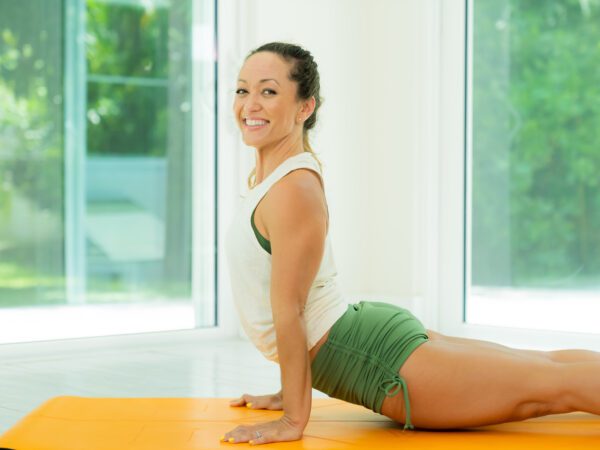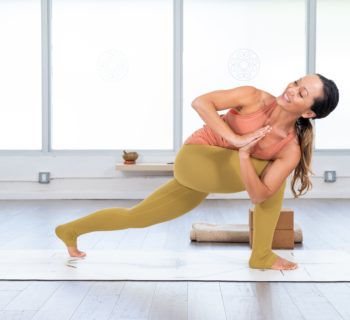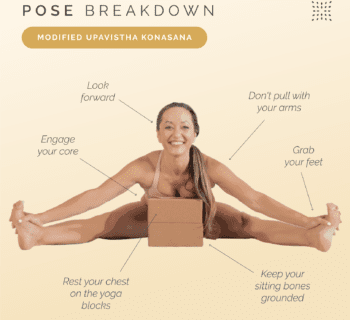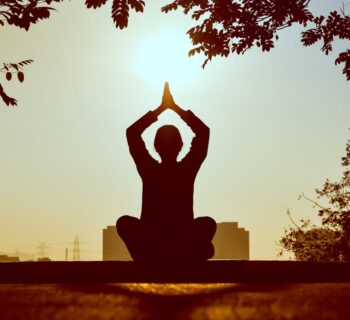Mastering a handstand requires a natural progression of strength and flexibility. By consistently practicing and focusing on the necessary elements, beginner and advanced yoga students can achieve their goal of performing a handstand with dedication and perseverance. Learning the essential skills and tips to balance upside down will give you a direct path for your handstand journey.
Establishing a Solid Foundation
Before even dreaming of floating up into a handstand, your odyssey begins with fortifying your body’s infrastructure. Cultivating a robust core strength, supple wrist flexibility, and stable shoulders forms the trinity of a handstand’s groundwork. Commitment to this foundational trifecta is indispensable, for it acts as the platform from which you launch into balance. Crafting this base requires regular engagement of targeted exercises—think planks for the core, wrist extensions, and rotations for flexibility, alongside shoulder exercises like downward dog or dolphin pose. Prioritize consistency over intensity; a daily dose of these strength and flexibility builders will lay the cobblestones on your path to handstand prowess.
Core Strength Essentials
The core is your stabilizing center in handstands, demanding endurance and control. Precision in strengthening exercises ensures progression toward this inverted balance.
A powerful core enables the body to resist gravity, which is crucial for maintaining alignment in a handstand. Engage in exercises such as planks, leg raises, and hollow holds with mindful attention to basic form.
Core strength underpins your inversion, forming a pillar for balance and control.
To track tangible improvement: note endurance in pose holds, increased ease in lifting into the handstand, and overall control. Documenting these metrics shines light on your core’s capability to power your handstand journey.
Shoulder Stability and Alignment
Shoulder stability is crucial for a solid handstand foundation. Weakness here leads to compromised form and increased injury risk.
By strengthening the rotator cuff and scapular muscles, you create a dependable platform for your handstand. This requires exercises that target not only power but also muscular endurance.
Remember, alignment isn’t just about strength; flexibility is key. Stretching the shoulders allows for a greater range of motion and a straighter handstand.
Incorporating drills like wall slides and shoulder taps can enhance stability. Aim for three to five sessions weekly, depending on your current fitness level and goals.
Alignment and stability go hand-in-hand, forming the backbone of handstand success. Ensure these elements are a regular focus in your practice.
Enhancing Body Awareness
Deepening your sense of body awareness is intrinsic to mastering the handstand. It’s about tuning into the subtleties of your posture and alignment, identifying imbalances or points of tension. This awareness facilitates the necessary micro-adjustments during practice, fostering a more refined and secure inversion.
As you progress toward the perfect handstand, cultivating body awareness is akin to learning a new language—a language of the flesh and bones. It demands consistent attention and exploration. Over time, enhanced proprioception, the understanding of your body’s position in space, becomes instinctive. This instinct governs the delicate equipoise required for the flawless execution of a handstand.
Balance and Coordination Drills
Balancing and coordinating drills are essential stepping stones to achieving a stable handstand. Try adding these poses to your yoga practice series.
- Crow Pose (Bakasana) – This arm balance hones focus and strengthens the core, essential for handstand stability.
- High Plank Shoulder Taps – Improve shoulder stability and coordination by alternating shoulder taps in a high plank position.
- Handstand Plank – Start in downward dog and walk your feet forward and shift your weight into your hands.
- Floating Tabletop – Practice lifting one arm and the opposite leg while on all fours to develop balance and cross-body coordination.
- Tree Pose (Vrksasana) With Eyes Closed – Enhance your proprioception by maintaining balance in Tree pose with the added challenge of no visual cues.
Mastering these exercises will enhance the neural pathways associated with balance.
Maintaining a delicate equilibrium while inverted becomes reflexive with repeated practice, paving the way to a solid handstand.
Mind-Body Connection Techniques
Visualization strengthens intention and focus.
For a handstand, envisioning yourself in the pose before attempting it is vital. Visualize every muscle engaging, your spine aligning perfectly, and your breath flowing steadily. By doing this, you create a neural blueprint in your brain, which helps align your mental and physical efforts when you attempt the actual handstand.
The power of breath cannot be overstated in this journey.
Inhale confidence, exhale doubt – this mantra can transform your practice. Deep yogic breathing, or pranayama, cultivates a calm mind and an energized body. Employ these techniques to harness your chi, or life force, grounding you in the present moment and fortifying your resolve.
Affirmations propel you towards your goal.
Speak positivity into your practice with affirmations like “I am strong, I am balanced.” Repeating such mantras as you train reinforces a belief in your capability and harnesses your subconscious mind to work towards your physical goals.
Trust is the foundation of progress.
As you cultivate these mind-body techniques, remember to trust in the process. The path to mastering handstands, coupled with mental conditioning, becomes a journey of self-discovery and resilience, guiding you to the peak of your potential.
Handstand Specific Training
Embarking on your handstand journey requires a blend of consistent practice and dedicated exercises that target the key muscle groups involved in this invigorating inversion. Begin with wrist conditioning to ensure the hands and forearms can support your body weight. Core strengthening is paramount to maintain alignment and balance, so incorporate planks, leg lifts, and hollow body hold exercises into your routine. Shoulder stability and mobility are also crucial; work on exercises like downward dog, dolphin poses, and handstand prep against the wall for this. To track your progression, document each practice session, noting improvements in form, balance duration, and any feelings associated with the experience. Your diligence and discipline will gradually steer you towards the pinnacle of a stable, controlled handstand.
Wrist Conditioning
Before aspiring to a stable handstand, the wrists must be fortified.
Start with gentle wrist rolls to increase the range of motion.
Progress to wrist stretches, extending and flexing to build flexibility.
Introduce palm pushes against a wall to establish strength.
Incorporate wrist walks, both forwards and backwards, to enhance endurance.
Elevate the wrists with resistance exercises like dumbbell wrist curls.
Persistent wrist conditioning is essential to withstand the demands of a handstand. Adequately conditioned wrists will act as a strong foundation, reducing injury risk.
Inversion Preparation Steps
Mastering handstands begins with foundational work targeting both strength and flexibility.
Establish core strength through exercises like planks, side planks, and hollow body holds.
Build shoulder stability and mobility with movements such as arm circles, pulling exercises, and wall slides.
Cultivate wrist strength and flexibility with practices outlined in the Wrist Conditioning section.
Practice hamstring and hip flexor stretches to improve the flexibility needed for a straight handstand line.
Incorporating these elements daily will create the robust framework essential for inversion.
Consistency in your preparation routine will significantly accelerate your handstand journey.
Progressive Handstand Practice
Developing a handstand is a symphony of balance, strength, and alignment, requiring a measured progression that respects the body’s learning curve. Gradually incrementing your practice, from wall-assisted holds to free-standing balance, allows your muscles and proprioception to adapt effectively, mitigating risk while enhancing capability. It’s about cultivating patience and persistence, ensuring that foundational elements are solidified before levitating into the apex of handstands.
Embrace the journey through structured milestones—a repertoire of drills like wrist rocks, frog stands, and shoulder taps, incrementally increasing in complexity. This strategic amplification of difficulty ensures your body’s readiness for each subsequent stage, fortifying the handstand with both the physical robustness and mental confidence necessary for mastery.
Wall-Assisted Handstands
A wall is an invaluable ally when first undertaking handstands, providing security and guidance as your body adjusts to inversion. It’s a controlled environment for practice.
Starting your journey here mitigates the risk of falling. Gradually, you’ll build confidence.
In the nascent stages of wall-assisted work, focus on distributing weight evenly across your palms, cultivating wrist strength and stability. It’s a crucible that tests and strengthens the shoulders, core, and balance needed for the eventual free-standing handstand.
Progress entails consistent, methodical practice against the wall until the body understands the alignment and balance points intrinsic to a solid handstand. It’s about developing the neuromuscular coordination for this inverted posture. As your strength and confidence soar, you’ll begin to peel away from the wall, moving closer to the coveted unassisted handstand. Remember, this is not a race but a personal journey of stability, strength, and poise.
Transitioning to Freestanding Handstands
Peeling away from the wall marks a pivotal shift in your handstand practice. It’s where confidence and ability intersect, propelling you towards autonomy.
In this phase, you might begin with “kick ups” in an open space, using momentum to find your balance point. As intimidating as it might feel, remember that falling is part of the learning curve. Cushion your practice area with a yoga mat or soft surface, and perhaps have a spotter guide your hips to alignment. Your palms must now intuitively manage the subtle shifts in weight, distributing it between your fingers and heel of the hand to maintain stability. The core and shoulders bear the brunt as you seek that sweet spot of equilibrium.
Practice is essential, and here, quality trumps quantity. Aim for regular, short sessions—perhaps five to ten minutes daily—to sharpen your proprioception in this inverted stance. Frequent practice helps you refine the minute adjustments needed to stay upright, training the body and mind to work in unison. Over time, these sessions accumulate into significant advancements, coaxing your muscles and reflexes into familiarity with the handstand posture.
As you progress, introducing variations like “tuck ups” and “straddle ups” can fortify your technique and build functional strength. By starting with bent legs or a straddled position and smoothly lifting into a handstand, you challenge your body to find alignment in motion. This step requires patience and incremental adjustment; don’t rush the process. The culmination of these efforts is a stable, freestanding handstand—a testament to your dedication and a spectacular showcase of strength, balance, and control. Keep consistently pushing the boundaries, and the freestanding handstand will evolve from a daunting endeavor to a liberated expression of your yoga practice.
Image by Maurice Müller from Pixabay









